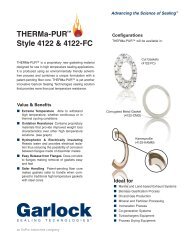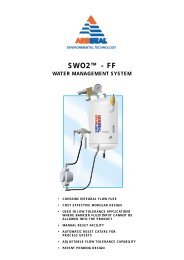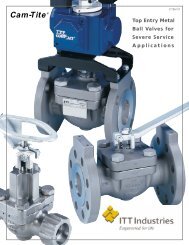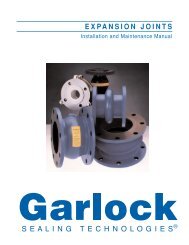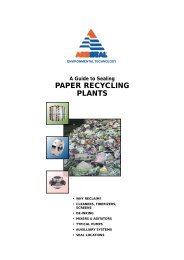automotive industry, pre-treatment & paint plants - AR Thomson Group
automotive industry, pre-treatment & paint plants - AR Thomson Group
automotive industry, pre-treatment & paint plants - AR Thomson Group
You also want an ePaper? Increase the reach of your titles
YUMPU automatically turns print PDFs into web optimized ePapers that Google loves.
AA U T O MM O T I VV EE<br />
AESSEAL ®<br />
AUTOMOTIVE<br />
INDUSTRY<br />
L-UK/US-AUTO-02<br />
IN 4379 - 01/2002<br />
4<br />
© Copyright 2002 AESSEAL plc All Rights Reserved.<br />
The Vehicle Paint<br />
Production Line<br />
The vehicle body is generally <strong>pre</strong>ssed and welded and transported to a <strong>pre</strong>-clean area. Here, high<br />
<strong>pre</strong>ssure water spray jets are directed at the body with the purpose of cleaning off dirt and debris from<br />
<strong>pre</strong>vious processes. This detritus can take many forms ranging from parts of components used in the<br />
production process, to operator refuse or items of clothing such as gloves.<br />
The vehicle is then transferred to the alkali dip rinse. The bodies are circulated through a series of dip<br />
tanks, which essentially degrease and clean the metal work. Each body is totally submerged in the<br />
caustic rinse, ensuring that no section is left untreated. Afterwards, the alkali dip excess fluid is drained<br />
from the vehicle body before the rinsing operation.<br />
During the dip rinse the full body of the vehicle is submerged in de-ionized water. This, like so many<br />
stages in the production process, is another cleaning operation. Next, the vehicle body goes onto the<br />
conditional spray. Spray pumps direct de-ionized water onto the vehicle body, generally at ambient<br />
temperatures before the phosphate operation.<br />
During the phosphate operation the body is completely submerged in a phosphate liquid which<br />
chemically etches the metal work and provides a layer of crystal on the surface of the steel. This enables<br />
the <strong>paint</strong> to ‘bite into’ the metal work for good adhesion.<br />
Occasionally, some <strong>plants</strong> opt for a partial phosphate dip, instead of a full phosphate dip, which is<br />
complemented by spray jets directing phosphate solution onto the roof of the vehicle. It is not<br />
uncommon to see many re-iterations of the same process, i.e. cleaning, etching, rinsing etc. This is a<br />
safeguard against wasted efforts further along the production line.<br />
The care and attention required in the <strong>pre</strong>-<strong>treatment</strong> makes this one of the most critical elements in the<br />
plant in obtaining a good <strong>paint</strong> finish.<br />
The phosphate system is sometimes referred to as "the bond". This is the part of the plant which bonds<br />
the <strong>paint</strong> to the steel body frame.<br />
Depending on the type of plant, a hot blower is sometimes employed. If the body is going into storage,<br />
the hot blower is commonly encountered. If the plant is a continuous production line then this stage is<br />
often omitted.<br />
From the phosphate operation, the body of the vehicle is transported to the <strong>pre</strong>paration deck and then<br />
onto the ELPO (Electro Coat Paint Operation), commonly referred to as the E-Coat, a water based<br />
<strong>paint</strong>ing operation. During the ELPO process, the body is immersed or dipped into electro-coat <strong>paint</strong>.<br />
The whole body is charged with electricity (similar to a plating process). The <strong>paint</strong> sticks to the body as<br />
the body is charged, as it effectively becomes a cathode whilst the <strong>paint</strong> becomes an anode.<br />
After this process the body is transported to an UF-dip (Ultra Filtrate) and then onto a UF-spray.<br />
Lastly the vehicle body goes through a DI-spray and DI-dip which is effectively a cleaning spray<br />
operation, then into an oven for approximately 20 minutes. Afterwards the body is transferred to the<br />
finishing plant where it is masked, PVC (Uniseal) sprayed, de-masked and sent to the sealer-deck for<br />
sealant to be applied between the seams and under the bonnet of the vehicle.



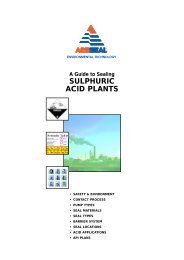
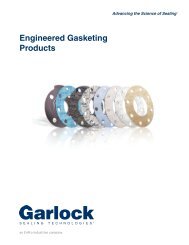
![VCS Flange Gasket [1.03 MB] - AR Thomson Group](https://img.yumpu.com/12044617/1/190x245/vcs-flange-gasket-103-mb-ar-thomson-group.jpg?quality=85)

![PGE Flange Gasket Product Brochure [1.04 MB] - AR Thomson Group](https://img.yumpu.com/12044595/1/190x245/pge-flange-gasket-product-brochure-104-mb-ar-thomson-group.jpg?quality=85)
